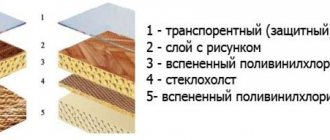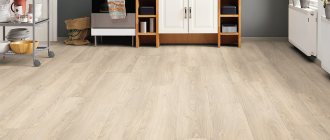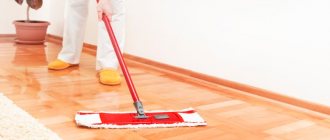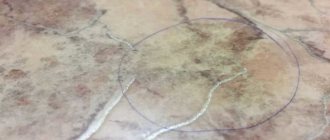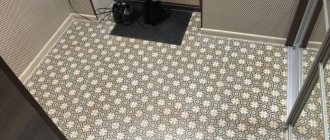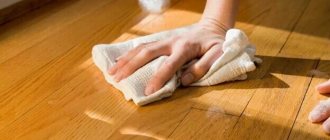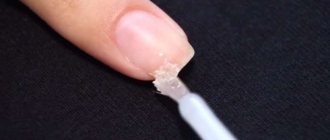The question of whether it is possible to lay new linoleum on old one may arise in several situations.
Or this is a superficial cosmetic repair, when you don’t really want to “spread the dirt.”
Or you bought an apartment, and recently the perfectly installed coating did not “fit” into your interior, or maybe you just got tired of the old one and wanted a new one.
Opinions among the masters were divided; it is difficult to answer unequivocally. If you understand it step by step, the question arises what are the pros and cons of leaving the old coating.
What is the plus and where is the minus?
If we are talking about old Soviet linoleum, then it’s clear: it needs to be removed. Dust, dirt that has accumulated in the seams, the base has probably already collapsed and turned into dust - it is not wise to cover it all with new linoleum.
Again, what is the condition of the floors under the old linoleum? If there are visible defects, it is better to remove this coating and make a new screed on the floor.
By laying new linoleum on the old one, there is a risk that the new one will go in waves, all the irregularities will be pressed through and the defects of the old coating will soon appear on the new one.
If the old linoleum was not glued, but only secured with baseboards, then it is still better to remove it and throw it away.
Sometimes the old coating can be easily removed, but if not, then you need to cut it into strips and remove them in stages, one by one.
In this case, a scraper and a spatula, and maybe even more serious tools, will come in handy:
- breaker scraper,
- Grinder,
- tear-off grip.
But it happens that the coating is glued “tightly” and without defects. Then you can leave it.
If you lay new linoleum on top of the old one, the floors will be softer, warmer, and the sound insulation in the room will improve.
And it takes less time to install, less labor and less dirt.
There cannot be a definite answer, since situations can be different. If you still decide to leave the old coating, you need to eliminate the existing deficiencies.
Laying linoleum on linoleum: reviews
- Oleg: I recently replaced the old floor with a new one, I just wanted something new. I laid the material directly on top of the old one. I must say that I have learned from my own experience how important it is to work with a well-prepared base - if the surface of the base sheet is not even enough and has visible changes, then it is almost impossible to get a high-quality new floor.
- Sergey: Not long ago I laid a new coating without removing the old one. I took a risk, even despite the rather large area of the room, approximately 28 m2. I laid the canvas on double-sided tape, secured it along the walls with skirting boards, and trimmed the threshold with a decorative strip. It even turned out pretty good.
- Elena: Please do not repeat my mistakes: under no circumstances move heavy furniture across the floor without lifting it off the surface.
And in conclusion, a video recommendation from a specialist on the problem of laying linoleum on an old one:
© 2021 prestigpol.ru
Elimination of defects
First you need to carefully examine the old linoleum, look at all the defects:
- holes,
- cracks,
- dents from furniture legs,
- bulges, etc.
Measure the thickness of the old coating (with a caliper), study its structure: how many layers, on what basis.
Ask around in markets and stores for remnants of old linoleum rolls and try to choose a piece for patches of the same thickness and structure as your old one.
The material purchased for patches is used as follows: cover defects (holes or dents) with it so that the patches are larger in size.
Then use a knife to cut a square in the coating, and it should cover the damaged part (be larger in size than the damage).
Remove the cut out old piece of linoleum, and put a new patch in its place - glue it with mastic, and join the joints using cold welding for linoleum.
Cold welding is a means, a kind of glue, that dissolves linoleum and can be used to seal gaps.
If there are small bubbles on the old coating, you need to get rid of them.
You can try using a syringe to inject glue inside and place a weight on top. Or put patches in place of the bubble.
Seams and cracks in old linoleum need to be filled with silicone sealant.
If the old one is pretty shabby
No matter how much we would like to console our reader, however, dilapidated material, which in some places has been fairly worn out or swelling is clearly visible on its surface, must be removed without any doubt. To support this statement, we present several compelling arguments.
- Dust. Once upon a time, such a coating had a fabric base, which not only was not particularly durable and quickly collapsed, but gradually rotted during use. Despite all the tricks of homeowners, over time, dust, residues of glue and covering material, and pieces of fabric accumulate in the substrate in huge quantities. This mixture is undoubtedly harmful to humans, so it is difficult to imagine that there will be many people who want to preserve such a base for a new flooring.
- Dirt. Even if the material does not have a woven base, over the years it still accumulates dust and dirt, especially at the joints of the fabrics, creating favorable conditions for the growth of bacteria, fungi, etc.
- Defects on the floor surface due to separation of the finished floor from the subfloor. Irregularities can vary in nature: dents, wavy or completely leaky areas. As is known, according to SNiP, the maximum difference in height of the floor covering cannot exceed 1–2 mm/m2. A condition that, in the presence of “dilapidated” flooring, will certainly be violated. In addition, areas with waves on the surface wear out much faster due to increased load.
By the way, PVC tiles cannot be laid on the uneven surface of this flooring material, since, most likely, being elastic, they can visually even aggravate the defects of the base.
All these arguments leave no more doubt that in this case the only possible answer to the question of whether it is possible to lay linoleum on linoleum is negative.
Thus, coatings that have problem areas definitely need to be removed. To make it easier to dismantle the old coating, professionals recommend cutting it into pieces in the form of strips. The material glued to the rough base is separated using a spatula, scraper, or a specially designed breaker scraper together with a tear-off clamp. For more complex surfaces, an electric cutter and grinder are often used.
Conditions for laying new linoleum on old
If you decide to put a coating on old linoleum, then it must be smooth, otherwise defects may appear in the new one. There should be no unevenness or potholes. There should be no traces of rot or fungus.
If the surface is flat, the old coating is hard, without defects, or they have already been eliminated, then you can begin laying linoleum.
It is clear that the room must be cleared of furniture, garbage must be removed, and the floors must be washed.
The new coating must be allowed to sit for at least one day, and sometimes it takes several days for it to completely smooth out and there are no waves.
You can cut the material in the store. It is advisable that the linoleum be laid in one continuous piece; if seams cannot be avoided, then there should be few of them.
Remove the baseboards. Leave the gap from the wall the same as the old covering.
If the room is less than 20 meters, then gluing linoleum is not necessary; fixing it with skirting boards will be enough.
On a larger area it is better to glue it. New linoleum should be smooth, without waves.
Glue is applied to it from the wrong side, pressed to the floor, and smoothed out. Then the baseboard is attached.
The glue is chosen depending on the base material; for a smooth base - latex, and for a fleecy base, PVA or Bustilat is suitable.
Another method of fastening - with adhesive tape - is unlikely to justify itself; the reliability of this method in this case is questionable.
If the coating consists of several sheets, then the joints need to be glued. Cold welding can be used.
How to glue linoleum to an old linoleum floor
How to glue linoleum to the floor without much difficulty? It is enough to do the following.
Preparatory stage
The first stage will consist of preparatory work. At this stage, you need to remove all the furniture from the room, remove the baseboards and strips that connect several panels.
Prepare the necessary materials and tools to make a smooth and reliable base: gloves, reactive glue for cold welding, masking tape, knife, spatula.
After all the baseboards and decorative thresholds have been removed, you need to make all the connections of the panels tight and even. To do this, do the following:
- At the junction of the canvases, masking tape is glued. It will serve as a limiter to prevent the glue from spreading over the entire surface.
- In the masking tape, you need to make a cut along the entire length with a knife.
- A special adhesive for cold welding must be applied to the prepared cut seam. For convenience, use a pointed tube.
Glue the joint with reaction glue type “A”
- After 10-15 minutes have passed, you can remove the masking tape.
- After another hour or so, the glue will dry completely, then it will be possible to level the surface. Using a sharp knife, cut off the excess and protruding parts of the seam.
After the seams are sealed, it is necessary to clean the surface from debris and dust, and then degrease the surface.
Material cutting
The preparatory stage will not be accompanied by an immediate transition to installation. The first step is to cut the roll to cover the entire area of the room.
Important! It is best to use a whole cloth. How to properly glue linoleum with a solid sheet? This is much easier because there is no need to seal the seams.
You need to cut the canvas with a margin so that the linoleum extends slightly onto the walls. The excess will be subsequently cut off. Having cut the roll into several parts, it is necessary to lay the sheets at the installation site and leave them for a day so that they rest and take the correct shape.
It is necessary to cut off the excess from the not yet glued canvas
Moreover, if there are two or more canvases, then they should overlap before gluing the linoleum. After gluing the linoleum is completed, it is imperative to weld the seams cut along the ruler.
Gluing linoleum
The new linoleum will be glued using glue. There are two types of adhesives:
- water-based dispersive;
- reactionary.
The peculiarity of the first is that it does not stick strongly to the base, so it is used over the entire area of the base. Reactive adhesive binds the coating to the base at the molecular level, so the places where it is used are at the edges and a couple of points in the middle.
In domestic conditions, it is better to plant linoleum on a dispersion composition
The installation process with dispersion adhesive is more complicated because it requires more work. First, the linoleum is rolled in half into a roll. The glue is spread on a notched trowel and spread over the exposed part of the base. After which they begin to roll out the roll on the floor, gradually attaching it with glue. Then the other part is glued in the same way.
It's much easier with reaction glue. The roll is also folded in half and the two parts are glued alternately, with glue applied only to some areas. To ensure the best adhesion, it is recommended to use a roller that is rolled over the surface.
Sealing seams
The final stage of installation will be sealing the seams. As already noted, the canvases are laid overlapping each other. Take a ruler or a long rule, according to which both canvases are cut at the same time. The resulting seam is sealed in the same way as described above.
As you can see, installation is not at all difficult. The main criterion for durability will be the choice of adhesive composition, which I would like to dwell on in more detail.
Which linoleum should I choose to lay on top of the old one?
If the old linoleum is glued “tightly”, absolutely smooth, then you can put thin baseless linoleum on top.
If you need to hide minor defects that can show through thin linoleum, or if thicker linoleum is simply more suitable for a given room, then lay this one.
There are so many masters, so many opinions. And no one will give a definite answer, without seeing the condition of the old linoleum, so to speak - in absentia.
You can simply state facts that confirm both one and the other opinion. The decision is yours. And you too will reap the results. Weigh the risks and go for it!
